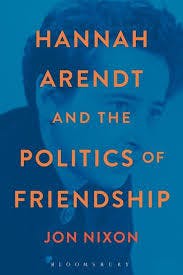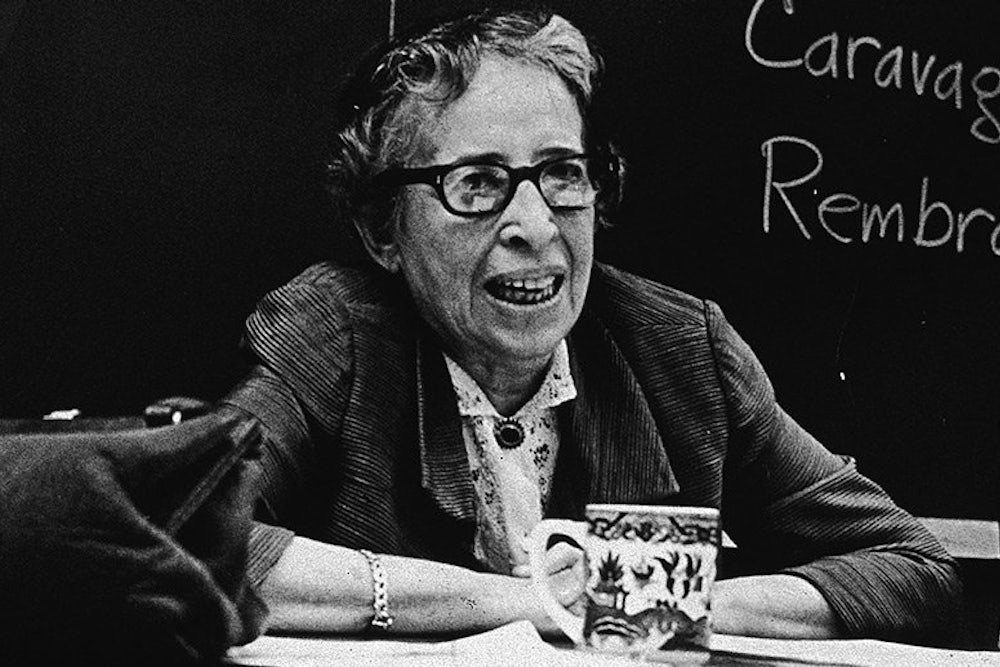Hannah Arendt was a good friend. When she was a teenage girl, she was forbidden by her mother and stepfather from visiting an acquaintance named Anne Mendelssohn, but she went anyway, walking to a nearby town at night, throwing pebbles at Anne’s window, and cementing a lifelong friendship. She came to the rescue of her friend and intellectual sparring partner Mary McCarthy after she suffered a traumatic miscarriage, as Jon Nixon tells us in his engaging biography, Hannah Arendt and the Politics of Friendship, and again while she was going through an emotionally draining divorce. She sent care packages to her former teacher and mentor Karl Jaspers when he and his wife were stuck in Germany, impoverished and hungry, after the war. She protected her husband Heinrich Blucher, as much a friend as a romantic partner, during his professional difficulties as an academic.

Arendt’s web of allegiances opens up a new avenue of approach into her career. More than a bodiless thinker, or a walking scandal, Arendt is depicted here as a woman hungry for companionship, and for the exchange of ideas. It also opens up an area of inquiry into the complex and under-explored dynamic of friendship. “Friendships are not the application of some theory of friendship,” Nixon writes, “nor do they rely on an ongoing reflective meta-dialogue between the friends regarding the nature of their friendship. ... There is a great deal that is appropriately and courteously implicit in friendship.” Nixon intends Arendt to be an exemplar of what he repeatedly hints is a now-lost era.
Arendt saw friendship as a middle ground between the solitude and solipsism of internal dialogue, and the terror of the public square. It was a protected space in which ideas could be unveiled, sanded down, hardened, and polished. Her friends were her intellectual compatriots, and her boundless loyalty toward them was also an expression of her deep-seated appreciation for their kindnesses. Friendship was an intensely appealing concept for a woman who spent much of her life as a refugee among refugees, a Jew expelled from her country of birth, adrift in foreign countries. It was a protective amulet, as well as a symbol of the higher values crushed under the boot of totalitarianism. Nazism’s mission was “to eradicate totally any trace of human freedom,” and friendship’s playfulness and compassion was a symbol of rebellion against fascism’s inhumanity.
Hannah Arendt was a bad friend. She stuck by Martin Heidegger after the war, even though she was presumably all too aware of the anti-Semitic line of thinking he pursued in his Black Notebooks, where he convolutedly argued that the Holocaust had been the responsibility of the Jews. Heidegger was her “supreme teacher,” according to Nixon, and his “almost complete silence” regarding her own successes, let alone his unforgivable wartime behavior, was not enough to keep Arendt away. “To be recognized by Heidegger,” in Nixon’s neat phrasing, “was, for Arendt, to be recognized.”
Arendt’s Eichmann in Jerusalem argued for the Holocaust as a crime against humanity, in which the German people had first resolved to do harm to the fabric of the world, and only secondarily selected the Jews as their victims. The intention was to render the Shoah a crime against all people, not merely the Jews, but it was another example of her difficulty with the notion of Jews as a people set apart. Invested in friendship, Arendt found being a friend to the Jewish people a challenge too far.
After publishing Eichmann in Jerusalem, Arendt was targeted for opprobrium by many of her fellow Jewish intellectuals, appalled by what they saw as her shoddy reasoning and misaligned sense of blame. Isaiah Berlin had her blackballed at Oxford. Her old friend and mentor Kurt Blumenfeld rejected her approaches, and died soon after without ever reconciling with her. Her longtime friend Gershom Scholem, with whom she had collaborated to preserve and promote the work of Walter Benjamin, was even angrier. In a letter written soon after Eichmann’s publication, he called “the banality of evil” a “catchword” and a “slogan.” “He charged Arendt with irresponsibility,” Nixon observes, “with misreading the role of the Jewish agencies under Nazi occupation and with lacking a ‘love of the Jewish people’—Ahabath Israel.”
Arendt had been judged by many of her old friends to have crossed an invisible line that separated thoughtful criticism from outright blasphemy, and unsentimental rationality from thoughtless brutality toward the dead. Loyal to her friends, she was notably lacking in generosity toward her fellow Jews.
Hannah Arendt was a fraught friend. Heidegger the self-absorbed German philosopher would likely not have thought much about Arendt in his infatuation with Nazi verve, but what kind of friendship can be founded in hatred for the most fundamental biographical facts of the other? Arendt’s continued admiration for Heidegger suggests a strain of self-loathing, or at the very least, a blindness to others’ disdain, that renders her an untrustworthy judge of character.
Arendt would argue, as she did, that “I have never in my life ‘loved’ any people or collective. … I indeed love ‘only’ my friends and the only kind of love I know of and believe in is the love of persons.” Turning a blind eye to such egregious failures of morality led to Eichmann in Jerusalem’s missteps, in which Arendt’s lack of “Ahabath Israel” made for a perverse accounting of the Holocaust.
Nixon argues that when we look at Arendt’s friendships, we are asking all the wrong questions. “The question for her,” he says, referring to her decades-long entanglement with Heidegger, “was not ‘How can I justify to myself my continuing friendship, affection, and loyalty to this man?,’ but ‘Given the irreversibility of my original encounter with this man, on what terms should I live out the consequences of that encounter?’”
But we can read Nixon’s book as much as a self-help manual as a work of philosophy or biography, in which the missing key to a fulfilled and emotionally healthy life is a sense of genuine friendship being as binding—perhaps more binding, given the divorce rampant in Arendt’s social circle—as marriage. “Marriage ends and desire fades,” Nixon summarizes Arendt’s argument to McCarthy during her divorce from her third husband Bowden Broadwater, “but friendship can and should endure.” Nixon depicts Arendt as a role model, in friendship if nothing else. She is an example to be studied and emulated, Nixon argues, in our moment of constant communication and infrequent communion.
The implication is that Arendt’s is a road not taken, one in which ferocious loyalty to old friends has been replaced by counts of mostly anonymous Facebook friends. Contemporary life favors quantity over quality, new experiences over familiar pleasures. To be loyal to old friends is seen as artificially limiting the panoply of experiences available in the world. But sturdy, stable friendships, as Nixon argues, are our testing ground and our protected space: “We need friendship because it eases the two-way flow between the private and the public, ensuring that we are neither overwhelmed by the world nor in denial regarding its plurality.”
The politics of Hannah Arendt’s friendships are, in the final accounting, a mixed bag. But Nixon gestures at the lesson we can all take away from her complex, well-examined, ultimately exasperating life: that without genuine, long-lasting friendships, made up of equal parts loyalty and affection and mischievousness and shared struggle, we are entirely alone in the world, our Twitter following be damned. “Friendship, for Arendt as for most of us,” Nixon tells us, “was an exercise in lifelong learning. It was—and is—how we learn to live together.”
